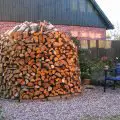As the name implies, firewood is wood that has been split, chopped, and dried so that it may be used as fuel for a fire. However, not all wood is the best fuel, and even wood that works well in one location may not be the best choice in another.
Even if you have the best firewood in the world at home for your log burner, you shouldn’t bring it on a long camping trip. Invasive pests and diseases brought in by foreign wood can, in the worst instance, wipe out the ecosystem of an entire forest as brutally as a wildfire.
When deciding what to use for your fire, there are numerous factors to take into account, like how difficult it is to split, how long it burns, and how much heat it creates. In this article, we’ll present all the best trees for firewood, their heat values, burn rates, smoke production, and much more!
Table of Contents
Best Trees for Firewood (A-Z)
Apple
Applewood burns at a medium rate and is significantly less popular for fireplaces than the other woods on our list since it is more difficult to ignite. But since it has a low smoke point and is therefore perfect for cooking, a lot of restaurants offer “applewood smoked” meats on their menus.
Amazingly fragrant apple wood imparts wonderful flavor when used to smoke meats. It is also quite pleasant in fireplaces because of its perfume. It is a more sophisticated wood, but it is difficult to light without an accelerant and can burn out quickly.
- Split ease: Low
- Ignition ease: Low
- Heat value: High
- Burn rate: Medium
- Smoke production: Low
- Seasoning length: 10 months
Ash
Seer or green, Ash is suited for a queen, according to an old English saying. This adage refers to the fact that ash has a naturally low moisture content and may therefore be burned even when it is not completely dried. One dried log of ash may burn for more than an hour, making it one of the materials with the longest burn times.
Even among hardwoods, its burn rate is one of the longest ever recorded. Ash has a light hue and a distinct, straight grain, making it firewood that is aesthetically beautiful. You’ll have a cozy home if you keep a few in your fireplace between fires.
- Split ease: High
- Ignition ease: High
- Heat value: Medium
- Burn rate: Long
- Smoke production: Low
- Seasoning length: 12 months
Beech
Beech trees produce some of the nicest and cleanest firewood, so if you’re fortunate enough to live in an area where these lovely trees are found, take advantage of that. Beeches are difficult to split for novices because they occasionally have a twist in the grain, but splitting them is not a dirty procedure because to their distinctive, smooth bark.
Beech is a firm, solid wood that burns for a very long time with hardly any sparks. You won’t have to worry about the bark flaking off and getting all over your living room floor, which is a huge advantage over other hardwoods like oak or ash.
- Split ease: Low
- Ignition ease: Low
- Heat value: High
- Burn rate: Slow
- Smoke production: Medium
- Seasoning length: 12 months
Black Locust
A lesser-known hardwood called black locust is preferred above oak or ash by many ardent admirers. It has one of the biggest heat outputs among well-liked hardwoods and is simpler to split than other hardwoods. Due to the slow burn rate and strong heat output, it produces long-lasting hot coals that are ideal for an overnight fire.
Black locusts have a quicker seasoning period than the majority of other hardwoods because of their rapid growth. Black locust trees feature sharp spines close to the leaves that can sneak up on you while you’re chopping, so use caution.
- Split ease: High
- Ignition ease: Low
- Heat value: High
- Burn rate: Medium
- Smoke production: Low
- Seasoning length: 6 months
Cherry
Cherry wood is a wonderful starter wood due to its simple splitting and quick seasoning time, despite the fact that it only provides a modest level of heat and burns pretty quickly. One of the simplest trees to split is the cherry tree, which can even be done with a single, clean strike.
If done correctly, cherry wood can be adequately seasoned in as little as six months. This implies that if you like to use firewood throughout the winter, you may buy enough in the spring to last you through the entire cold weather. Due to its mild and pleasant smell, cherry is also one of the most used woods for campfires and fireplaces.
- Split ease: High
- Ignition ease: Low
- Heat value: Medium
- Burn rate: Medium
- Smoke production: Low
- Seasoning length: 6-9 months
Chestnut
Although chestnut makes excellent firewood, only one of the three common chestnut trees found in the USA, the American Chestnut, is suitable for use as firewood. Make sure you’re cutting down the proper sort of chestnut, because Chinese and horse chestnuts are not suitable for use as firewood. You’ll be in for a treat once you’ve discovered an American chestnut.
They have a pleasantly fragrant scent that will linger in your house for hours after the fire has been put out, are simple to split, and are light. Chestnut flames are relatively modest, manageable, and produce a lot of heat for their size.
- Split ease: High
- Ignition ease: High
- Heat value: Medium
- Burn rate: Slow
- Smoke production: Low
- Seasoning length: 24 months
Douglas Fi
For novices, Douglas fir is the best kind of firewood. It is widely available across the nation, quite simple to split, and creates a lot of heat without creating a lot of sparks. It is simple to cut it into pieces that are the size of kindling due to the straight grain and few knots. Despite being softwoods, Douglas firs are nonetheless rather dense.
This makes them lighter than hardwood trees while maintaining a respectable burn time. Because they generate less sap than other species in the same family and because they smell fantastic, Douglas firs are the favored fir trees. Since Douglas firs are the most common type of Christmas tree, using them as firewood will make you feel especially festive.
- Split ease: High
- Ignition ease: High
- Heat value: High
- Burn rate: Fast-Medium
- Smoke production: High
- Seasoning length: 6 months
Hickory
Another common choice for firewood is hickory, which some people choose as their top option in general. Although it is incredibly challenging to split, the effort is definitely worth it because it is one of the woods that burns the longest.
Additionally, it provides more than enough heat and is simple to light. You can utilize hickory before it has fully seasoned because wood is so simple to fire. Unlike other hardwoods, it won’t burn as well while it’s fresh, but you can still light it and start a respectable fire with it.
- Split ease: Low
- Ignition ease: High
- Heat value: High
- Burn rate: Slow
- Smoke production: Medium
- Seasoning length: 12 months
Honey Locust
The honey locust and its cousin, the black locust, are quite similar, but the honey locust is even simpler to split and burns more slowly. It is an excellent wood to use outdoors and in fireplaces since it is highly dense and resistant to rot and dampness.
Honey locust is particularly useful for cooking since it produces fine red coals that will evenly heat food both inside and outside. Since honey locust takes a while to season, it must be completely seasoned before use to prevent excessive smoke production.
- Split ease: High
- Ignition ease: High
- Heat value: High
- Burn rate: Slow
- Smoke production: Low
- Seasoning length: 24 months
Maple
Don’t ignore them just because of their tasty syrup; maple trees also make excellent firewood. Like oak and ash, maple is a hardwood, but it is less dense than most of its kind, making it much easier to split and lighter than others. The smooth burn and simple handling of maple make it a wonderful fuel for beginners.
Additionally, it smells fantastic! It burns steadily from beginning to end and produces one of the least amounts of smoke. You’ll need more of it because maple is softer than the majority of other hardwoods. However, because the season is so brief, you won’t have any trouble utilizing a sufficient amount.
- Split ease: Yes
- Ignition ease: Yes
- Heat value: Medium
- Burn rate: Slow
- Smoke production: Low
- Seasoning length: 5 months
Mulberry
Mulberry, albeit less popular than other hardwoods, is a hidden gem for slightly more experienced fire starters. It can be challenging for beginners to handle because it emits more smoke than the majority of other hardwoods. The reward is enormous if you can tame these logs, though. Mulberry burns over a very long time and at a very high temperature.
However, it can be hazardous in open fireplaces inside because of how much sparking it produces. One of the greatest scents of any firewood comes from mulberry. It has a strong aroma that can fill any indoor or outdoor environment and is a blend of sweet and smoky notes.
- Split ease: High
- Ignition ease: High
- Heat value: High
- Burn rate: Slow
- Smoke production: Medium
- Seasoning length: 12 months
Oak
One of the most often burned types of wood is oak, and for good reason. It is one of the strongest and hardest woods, and it is widely used in the United States and Canada. The fact that oaks require around 150 years of growth before they are useful as firewood is compensated for by this commonality. Like all other firewood trees, oak burns best after being “seasoned,” which is a painfully long process for this particular tree species.
It will, however, produce a perfect-sized domestic flame that burns slowly while still generating a ton of heat once it has been properly seasoned. Typically fashioned of wood, the traditional English yule log is burned by many each Christmas.
- Split ease: High
- Ignition ease: Low
- Heat value: High
- Burn rate: Slow
- Smoke production: Low
- Seasoning length: 24 months
Poplar
Poplar is a slightly debatable option for firewood. Since it’s one of the softer softwoods available, a chainsaw will be required to split it as opposed to an ax. Because of this and the high spark content, some individuals choose tougher woods over poplar.
However, softwoods like poplar do have some significant advantages. Logs are simple to handle, transport, and store because of their low density. It is ideal to use at the start and end of the season when there is less access to more conventional firewood because it takes less time to season.
- Split ease: Low
- Ignition ease: High
- Heat value: Low
- Burn rate: Fast
- Smoke production: Medium
- Seasoning length: 6 months
Sycamore
Because it burns so quickly, sycamore is a little tricky for firewood. However, it is rather typical for people to have a large number of sycamores on a single property, making it accessible and simple for homeowners to use. Sycamore is a low-density hardwood, putting it in between softer wood and more dense hardwoods like oak.
As a result, splitting and seasoning are a little more difficult. On the other hand, it burns quite brightly and evenly and is very simple to ignite. Sycamore burns quickly and a little aggressively, making it ideal for campfires or lighting a Christmas celebration.
- Split ease: Low
- Ignition ease: High
- Heat value: Low
- Burn rate: Fast
- Smoke production: Medium
- Seasoning length: 24 months
Walnut
Because it burns cleanly and produces medium heat, walnut is a traditional firewood that is adored by all. The neutral nature of walnut makes it the ideal firewood for novices. In contrast to other hardwoods, it is both simple to split and simple to ignite, and it is widely distributed throughout the United States.
Due to their low sap production, walnut trees are even simpler to split. The woodsy scent of walnut wood, which will make your house smell like a charming log cabin, is one of its best features. Walnut is an excellent complement to a fire that also includes oak or ash logs because of how quickly it burns.
- Split ease: High
- Ignition ease: High
- Heat value: Medium
- Burn rate: Slow
- Smoke production: Low
- Seasoning length: 15 months
If you’re planning to go chop down some firewood ready for the winter, you may be interested in picking out the most suitable chainsaw:
- Best Firewood Chainsaw: Top Picks & Reviews
- Best Chainsaws: Top Picks, Reviews & Buying Guide
- 6 Best Budget Chainsaws: Top Picks & Reviews
- Best Left Handed Chainsaw
- Types of Hand Saws – A Visual Guide on Which Hand Saw to Use & When
Firewood Seasoning and Burning Tips
Here are some suggestions for seasoning and burning that wood now that you are aware of the best trees for making firewood.
Seasoning Firewood
Wood that has had the majority of its moisture removed is considered well-seasoned firewood. When wood burns, there is still a lot of moisture present if you notice steam coming from it or hear popping or hissing as it burns. Typically, well-seasoned firewood has blackened ends as well as apparent cracks and spits. Additionally, it will be thin and produce a characteristic “clinking” sound when two pieces are struck against one another.
What Is Considered too Much Moisture?
In general, you shouldn’t put wet (also known as green) wood in your fireplace or woodstove if it has more than 25% moisture content. When chopping fresh wood, it frequently has about 50% moisture. Before burning the wood, it is advisable to season it so that the moisture content is under 25%.
What Is Heat Value?
The amount of heat generated when burning wood is what determines the heat value of the material. The values are divided up as follows:
- Low heat value – equal to the heat generated by burning 100 to 150 gallons of fuel oil
- Medium heat value – equal to the heat generated by burning 150 to 200 gallons of fuel oil
- High heat value – equal to the heat generated by burning 200 to 250 gallons of fuel oil
FAQs (Frequently Asked Questions)
What trees should not be used for firewood?
Avoid purchasing firewood from evergreen trees, such as pine, fir, or cypress, as they are softwoods. In addition to this, unseasoned or newly cut wood. Freshly cut wood from the tree is still dripping with moisture from the environment. The wood is now more challenging to burn as a result.
What tree grows the fastest for firewood?
One of the fastest-growing trees in the world is the willow tree, commonly referred to as the Usain Bolt of trees. The willow is one of the greatest trees to grow throughout the year for use as firewood because of its good form and high production. The willow tree is very affordable and quite simple to grow.
How do you know if a tree is good for firewood?
If you buy your firewood, be sure it has been aged for at least a year and has been stored in a way that prevents moisture from seeping back in after each rainstorm. Compared to green wood of the same species, seasoning gives the wood a dark or gray appearance. It is brittle and has fissures running through every piece when you split it.
How long should a tree dry before burning?
Actually, the type of wood determines how long it takes to season. If done correctly, softwood can be cured in less than six months. Hardwood, such as oak, can take anywhere between one and two years.





